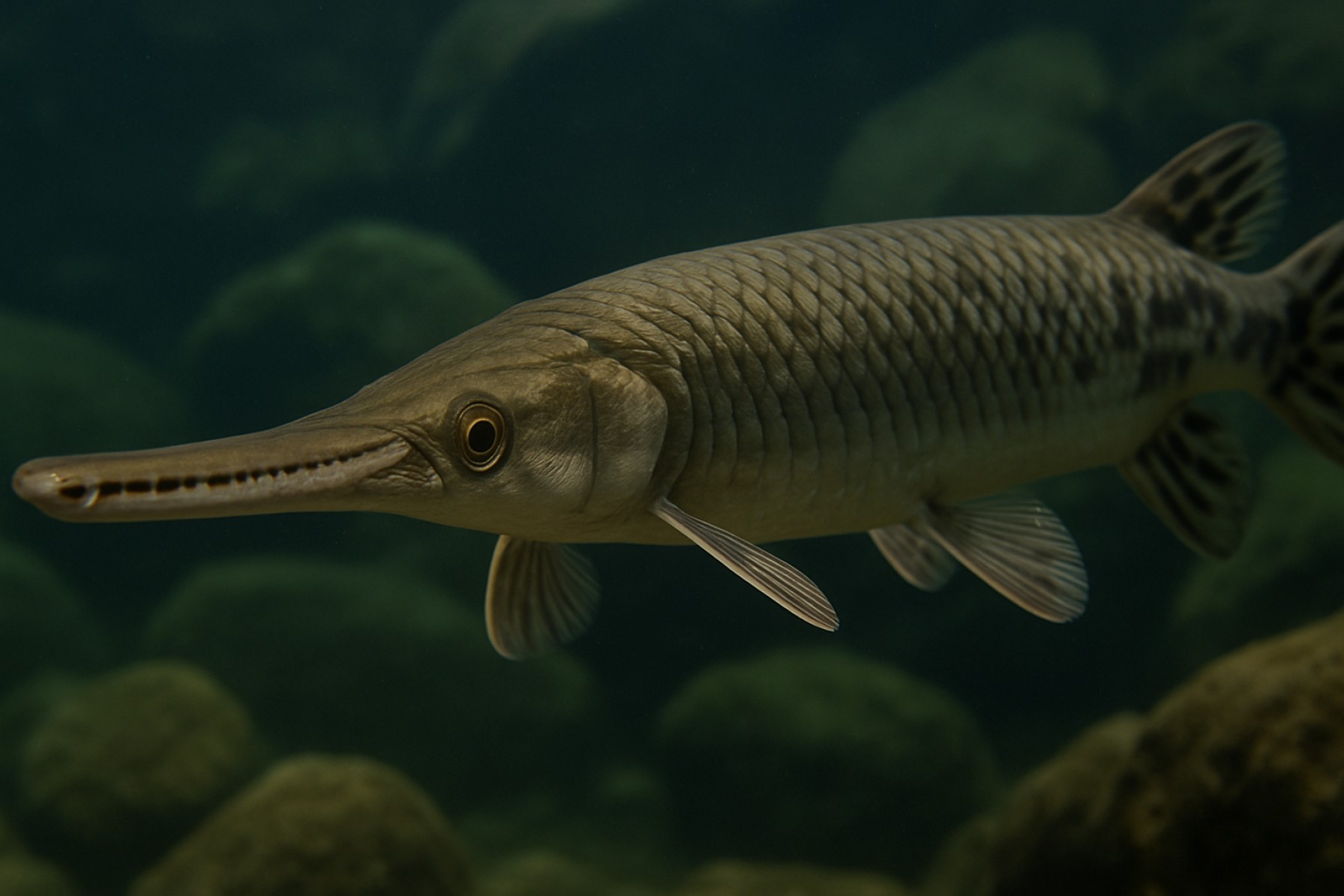Unlocking the Secrets of the Longnose Gar: Evolution’s Living Fossil and Its Surprising Role in Modern Ecosystems
- Introduction: Meet the Longnose Gar
- Evolutionary Origins and Fossil Record
- Physical Adaptations and Unique Features
- Habitat Range and Environmental Preferences
- Feeding Behavior and Hunting Strategies
- Reproduction and Life Cycle Insights
- Ecological Impact and Food Web Role
- Conservation Status and Threats
- Human Interactions and Cultural Significance
- Future Research and Conservation Initiatives
- Sources & References
Introduction: Meet the Longnose Gar
The longnose gar (Lepisosteus osseus) is a distinctive freshwater fish native to North America, easily recognized by its elongated, torpedo-shaped body and exceptionally long, narrow snout filled with sharp teeth. This ancient species belongs to the family Lepisosteidae, a group of “gar” fishes that have existed for over 100 million years, making them living representatives of a lineage that dates back to the time of the dinosaurs. The longnose gar is found in a wide range of aquatic habitats, including rivers, lakes, and reservoirs, particularly throughout the eastern and central United States, as well as parts of northern Mexico and southern Canada.
Longnose gars are notable for their tough, ganoid scales, which provide armor-like protection and contribute to their prehistoric appearance. Adults can reach lengths of up to 6 feet (1.8 meters), though most individuals are smaller. Their long, beak-like jaws are lined with sharp teeth, perfectly adapted for catching fish, their primary prey. The species is an ambush predator, often lying motionless near the water’s surface before striking rapidly at unsuspecting prey.
This fish is also remarkable for its ability to survive in low-oxygen environments, thanks to a specialized swim bladder that functions much like a lung, allowing it to gulp air at the surface. This adaptation enables the longnose gar to thrive in waters where many other fish would struggle to survive. The species plays an important ecological role as both predator and prey, helping to maintain the balance of aquatic ecosystems.
The longnose gar is of interest not only to scientists studying evolutionary biology and fish ecology, but also to anglers and naturalists who appreciate its unique appearance and behavior. While not typically targeted as a food fish, it is sometimes sought after for sport due to its size and strength. Conservation organizations and fisheries agencies, such as the U.S. Fish and Wildlife Service and the NOAA Fisheries, monitor gar populations and their habitats to ensure their continued presence in North American waters. Understanding and appreciating the longnose gar offers a fascinating glimpse into the resilience and diversity of freshwater life.
Evolutionary Origins and Fossil Record
The longnose gar (Lepisosteus osseus) is a member of the family Lepisosteidae, a lineage of ray-finned fishes (Actinopterygii) with a remarkable evolutionary history. Gars are considered “living fossils” due to their retention of many primitive features, such as ganoid scales and a heterocercal tail, which are reminiscent of ancient actinopterygians. The evolutionary origins of gars trace back to the Mesozoic era, with fossil evidence indicating that the family Lepisosteidae first appeared during the Late Jurassic period, over 150 million years ago. These early gars already exhibited many of the anatomical characteristics seen in modern species, suggesting a slow rate of morphological change over time.
The fossil record of gars is extensive and well-documented, particularly in North America, where both extinct and extant species have been found. Fossilized gar remains, including scales, vertebrae, and skull elements, have been recovered from Cretaceous and Paleogene deposits, demonstrating the persistence and adaptability of this group through major geological and climatic events. Notably, the genus Lepisosteus itself is known from the Cretaceous period, indicating that the longnose gar and its close relatives have survived multiple mass extinction events and environmental shifts.
The evolutionary conservatism of gars is reflected in their morphology and genetic makeup. Comparative studies of gar genomes have revealed that they possess a unique combination of ancestral and derived genetic features, providing valuable insights into vertebrate evolution. Gars are of particular interest to evolutionary biologists because they occupy a phylogenetic position between teleost fishes (the most diverse group of modern fishes) and more basal actinopterygians, making them a key taxon for understanding the early diversification of ray-finned fishes. The sequencing of the spotted gar genome, a close relative of the longnose gar, has further illuminated the evolutionary relationships among vertebrates and the origins of key genetic innovations (National Institutes of Health).
Today, the longnose gar continues to inhabit freshwater and brackish environments across eastern North America, serving as a living representative of an ancient lineage. Its fossil record and evolutionary history underscore the resilience and adaptability of gars, as well as their significance in the broader context of vertebrate evolution (Smithsonian Institution).
Physical Adaptations and Unique Features
The Longnose Gar (Lepisosteus osseus) is a distinctive freshwater fish native to North America, renowned for its remarkable physical adaptations and unique features that have enabled its survival for millions of years. One of the most striking characteristics of the Longnose Gar is its elongated, torpedo-shaped body, which is covered in thick, diamond-shaped ganoid scales. These scales are composed of a hard, enamel-like substance called ganoine, providing the fish with exceptional protection against predators and environmental hazards. This ancient armor is a key evolutionary trait, setting gars apart from most modern fishes.
The species’ most recognizable feature is its extremely long, narrow snout, which can comprise up to 20% of its total body length. This snout is lined with sharp, conical teeth, perfectly adapted for grasping and holding onto slippery prey such as fish and crustaceans. The elongated jaws allow the Longnose Gar to make quick, sideways strikes, an effective hunting strategy in the slow-moving waters it typically inhabits. The placement and structure of the teeth also prevent prey from escaping once captured.
Another notable adaptation is the Longnose Gar’s ability to breathe both in water and air. In addition to gills, it possesses a highly vascularized swim bladder that functions much like a lung. This adaptation enables the gar to survive in low-oxygen environments, such as warm, stagnant backwaters, by gulping air at the surface. This dual respiratory system is relatively rare among fish and is a significant factor in the gar’s resilience and wide distribution.
The Longnose Gar’s coloration further aids its survival. Its olive-brown to greenish back and sides, with a lighter belly, provide effective camouflage among aquatic vegetation and submerged logs. Juveniles often display dark spots on their bodies and fins, which help them blend into their surroundings and avoid predation.
These physical adaptations—armor-like scales, an elongated snout with specialized teeth, a dual respiratory system, and cryptic coloration—have allowed the Longnose Gar to thrive in diverse and sometimes challenging habitats. The species is considered a living fossil, with many of its features remaining largely unchanged for over 100 million years, as noted by organizations such as the U.S. Fish and Wildlife Service and the National Marine Fisheries Service, both of which play key roles in the study and management of North American fish species.
Habitat Range and Environmental Preferences
The longnose gar (Lepisosteus osseus) is a freshwater fish species native to North America, recognized for its elongated snout and prehistoric lineage. Its habitat range is extensive, spanning much of the eastern and central United States, parts of northern Mexico, and southern Canada. The species is commonly found in large rivers, lakes, reservoirs, and backwaters, particularly those with slow-moving or still waters. Longnose gar are highly adaptable and can tolerate a wide range of environmental conditions, which contributes to their broad distribution.
Longnose gar prefer habitats with abundant aquatic vegetation, submerged logs, or other structures that provide cover and ambush points for hunting. They are often associated with clear to moderately turbid waters, but their ability to gulp atmospheric air allows them to survive in low-oxygen environments where many other fish species cannot thrive. This adaptation is facilitated by their vascularized swim bladder, which functions similarly to a lung, enabling them to exploit habitats that experience periodic hypoxia.
Geographically, the longnose gar’s range extends from the Great Lakes and the St. Lawrence River basin in the north, down through the Mississippi River drainage, and into the Gulf Coastal Plain. They are also present in the lower reaches of the Rio Grande and other river systems in Texas and northern Mexico. In Canada, their distribution is primarily limited to southern Ontario and Quebec. The species’ presence in these diverse regions reflects its tolerance for a variety of water temperatures, salinities, and substrate types.
Longnose gar are most frequently found in warm, shallow waters during the spring and summer months, particularly in areas with slow currents and dense vegetation. During colder months or periods of drought, they may move to deeper waters or seek refuge in main river channels. Their environmental preferences make them important indicators of aquatic ecosystem health, as they require relatively intact habitats with sufficient cover and water quality.
Conservation and management of longnose gar habitats are overseen by various state and federal agencies in the United States, such as the U.S. Fish and Wildlife Service, which monitors fish populations and aquatic habitats. In Canada, agencies like Fisheries and Oceans Canada play a similar role. These organizations work to ensure the sustainability of native fish populations and the preservation of critical aquatic environments.
Feeding Behavior and Hunting Strategies
The longnose gar (Lepisosteus osseus) is a predatory fish native to freshwater systems across North America. Its feeding behavior and hunting strategies are highly specialized, reflecting adaptations to both its environment and prey. Longnose gars are primarily piscivorous, meaning their diet consists mainly of other fish, although they may occasionally consume crustaceans and insects, especially during their juvenile stages.
Longnose gars are ambush predators, relying on stealth and patience rather than active pursuit. Their elongated, torpedo-shaped bodies and long, narrow snouts allow them to remain nearly motionless in the water, often among submerged vegetation or near the water’s surface. This camouflage, combined with their olive-brown coloration, helps them blend seamlessly into their surroundings, making it easier to surprise prey. When a potential meal approaches, the gar uses a rapid sideways snap of its jaws to seize the prey, utilizing its sharp, needle-like teeth to secure slippery fish.
Their hunting is most effective in slow-moving or still waters, such as backwaters, oxbow lakes, and sluggish rivers, where visibility is often reduced and prey is abundant. Longnose gars are known to hunt both during the day and at night, but they are particularly active at dawn and dusk, taking advantage of low light conditions to ambush unsuspecting prey. Their ability to gulp air and utilize a vascularized swim bladder as a primitive lung allows them to thrive in low-oxygen environments where other predatory fish might be less effective, giving them access to prey in habitats that are otherwise inhospitable.
The feeding strike of the longnose gar is characterized by remarkable speed and precision. Studies have shown that the gar’s elongated jaws can open and close rapidly, minimizing the chance for prey to escape. After capturing prey, the gar often manipulates it head-first into its mouth to facilitate swallowing, a behavior common among piscivorous fish to prevent injury from spines or scales.
Longnose gars play a significant ecological role as apex or near-apex predators in their habitats, helping to regulate fish populations and maintain ecosystem balance. Their feeding strategies and physiological adaptations have been the subject of research by organizations such as the United States Geological Survey and the U.S. Fish and Wildlife Service, both of which monitor native fish populations and aquatic ecosystem health across North America.
Reproduction and Life Cycle Insights
The longnose gar (Lepisosteus osseus) exhibits a distinctive reproductive strategy and life cycle that reflects its adaptation to freshwater habitats across North America. Spawning typically occurs in the spring, when water temperatures rise to between 20°C and 25°C. During this period, adult longnose gars migrate from deeper waters to shallow, vegetated areas along riverbanks, lakeshores, and backwaters. These environments provide optimal conditions for egg deposition and early development.
Females are generally larger than males and can produce between 4,000 and 77,000 eggs per spawning season, depending on their size and age. Spawning is a communal event, often involving several males accompanying a single female. The female releases adhesive eggs onto submerged vegetation, woody debris, or gravel substrates. The eggs are coated with a toxic substance, which helps deter predation by other aquatic organisms. Fertilization is external, with males releasing sperm over the eggs as they are deposited.
The incubation period for longnose gar eggs is relatively short, typically lasting 6 to 8 days, depending on water temperature. Upon hatching, the larvae possess an adhesive organ on their snout, allowing them to attach to vegetation and remain stationary while absorbing their yolk sac. This adaptation reduces predation risk during the vulnerable early stages of development. After the yolk sac is absorbed, juvenile gars become free-swimming and begin feeding on small invertebrates and fish larvae.
Longnose gars exhibit rapid growth during their first year, with juveniles reaching lengths of up to 30 centimeters. Sexual maturity is generally attained between 3 and 4 years of age for males and 6 years for females. Adult longnose gars are long-lived, with some individuals documented to exceed 20 years in the wild. Their longevity and late maturity contribute to a relatively slow population turnover, making them sensitive to environmental changes and habitat degradation.
The reproductive success and life cycle of the longnose gar are closely tied to the availability of suitable spawning habitats and water quality. Conservation efforts by organizations such as the U.S. Fish and Wildlife Service and the National Marine Fisheries Service focus on maintaining healthy aquatic ecosystems to support the species’ natural breeding behaviors and population stability. Understanding the reproductive biology of the longnose gar is essential for effective management and conservation of this ancient fish species.
Ecological Impact and Food Web Role
The longnose gar (Lepisosteus osseus) is a large, ancient fish species native to freshwater systems across eastern and central North America. As a top-level predator, the longnose gar plays a significant role in shaping aquatic ecosystems and maintaining the balance of food webs. Its ecological impact is multifaceted, influencing both prey populations and the broader community structure.
Longnose gars primarily feed on smaller fish, such as shad, sunfish, and minnows, but their diet can also include crustaceans and insects. By preying on abundant forage fish, they help regulate these populations, preventing any single species from becoming overly dominant. This predatory pressure can promote biodiversity by allowing less competitive species to persist within the ecosystem. The gar’s feeding habits also contribute to the cycling of nutrients, as they consume prey and excrete waste, which supports primary productivity in aquatic environments.
Despite their reputation as voracious predators, longnose gars are not considered a threat to game fish populations. Studies have shown that they rarely consume significant numbers of sport fish, instead focusing on more plentiful, smaller species. This selective predation helps maintain a balanced fish community and can even benefit game fish by reducing competition for food resources. The U.S. Fish and Wildlife Service, a federal agency responsible for the management and conservation of fish, wildlife, and natural habitats, recognizes the ecological importance of native predatory fish like the longnose gar in sustaining healthy aquatic systems.
Longnose gars themselves serve as prey for larger predators, particularly when they are young. Birds of prey, such as ospreys and eagles, as well as larger fish and alligators, may feed on juvenile gars. This positions the longnose gar as both predator and prey within the food web, contributing to energy transfer across trophic levels.
The presence of longnose gar is often an indicator of a healthy, functioning ecosystem. Their tolerance for low-oxygen environments allows them to inhabit areas where other fish might not survive, further diversifying the ecological niches within a water body. Conservation organizations, including the American Fisheries Society, emphasize the importance of protecting native species like the longnose gar to preserve ecosystem integrity and resilience.
Conservation Status and Threats
The longnose gar (Lepisosteus osseus) is a freshwater fish native to North America, recognized for its elongated body and distinctive long snout. Its conservation status is generally considered stable across much of its range, but localized threats and habitat changes have prompted monitoring and management efforts by various agencies. According to the International Union for Conservation of Nature (IUCN), the longnose gar is currently listed as a species of “Least Concern,” reflecting its wide distribution and large, stable populations. However, this status does not preclude the species from facing region-specific challenges.
Habitat degradation is a primary threat to longnose gar populations. The species relies on slow-moving rivers, lakes, and backwaters with abundant vegetation for spawning and feeding. Activities such as dam construction, channelization, and wetland drainage can disrupt these habitats, leading to population declines in affected areas. The U.S. Fish and Wildlife Service, a federal agency responsible for the management and conservation of fish and wildlife in the United States, has identified habitat loss and water quality degradation as significant concerns for many native fish species, including the longnose gar.
Pollution, particularly from agricultural runoff and industrial discharges, poses another threat by reducing water quality and affecting the availability of suitable spawning sites. Elevated levels of nutrients and contaminants can lead to algal blooms and hypoxic conditions, which are detrimental to both adult and juvenile gars. The U.S. Environmental Protection Agency (EPA) monitors and regulates water quality standards to help mitigate these impacts, but localized pollution events can still have significant effects on gar populations.
Overfishing and unregulated harvest have historically impacted longnose gar in some regions, especially where the species is targeted for sport or commercial purposes. While not typically a primary target, gars are sometimes removed as bycatch or due to misconceptions about their role in aquatic ecosystems. State-level wildlife agencies, such as those coordinated under the Association of Fish & Wildlife Agencies, implement regulations and outreach programs to promote sustainable management and public awareness of native fish species, including the longnose gar.
Climate change represents an emerging threat, with potential impacts on water temperature, flow regimes, and habitat availability. Ongoing research and monitoring by organizations such as the U.S. Geological Survey (USGS) are essential for understanding how these changes may affect longnose gar populations in the future. Continued conservation efforts and habitat protection are crucial to ensuring the long-term viability of this ancient and ecologically important species.
Human Interactions and Cultural Significance
The longnose gar (Lepisosteus osseus) has played a notable role in human societies, particularly in North America, where it is native to many freshwater systems. Historically, Indigenous peoples utilized the longnose gar for both practical and cultural purposes. Its tough, armor-like scales were fashioned into tools, arrowheads, and even protective coverings, reflecting the resourcefulness and ingenuity of these communities. The flesh of the gar was also consumed, though its strong flavor and bony structure made it less popular than other fish species.
In modern times, the longnose gar is often regarded as a “rough fish” by anglers, meaning it is not typically targeted for sport or commercial fishing compared to more popular game fish. However, some fishing enthusiasts appreciate the challenge posed by the gar’s elusive behavior and powerful jaws. Bowfishing for longnose gar has gained popularity in certain regions, as the fish’s surface-breathing habits and distinctive appearance make it a unique quarry.
Culturally, the longnose gar has been the subject of folklore and local legends, sometimes viewed with a mixture of awe and superstition due to its prehistoric appearance and formidable teeth. In some areas, misconceptions about the gar’s impact on game fish populations have led to negative perceptions, though scientific studies indicate that longnose gar play an important ecological role as both predator and prey in their habitats.
Conservation organizations and state wildlife agencies, such as the U.S. Fish and Wildlife Service and various state departments of natural resources, have recognized the ecological significance of the longnose gar. These agencies provide educational resources to dispel myths and promote the species’ role in maintaining healthy aquatic ecosystems. The longnose gar is not currently considered threatened or endangered, but habitat degradation and water pollution remain concerns for its long-term well-being.
In recent years, there has been a growing appreciation for the longnose gar among naturalists and biologists, who value the species as a living representative of ancient lineages dating back over 100 million years. This recognition has contributed to a shift in public perception, encouraging greater respect for the gar’s place in North America’s natural and cultural heritage.
Future Research and Conservation Initiatives
Future research and conservation initiatives for the Longnose Gar (Lepisosteus osseus) are increasingly important as freshwater ecosystems face mounting pressures from habitat alteration, pollution, and climate change. Although the Longnose Gar is currently listed as a species of Least Concern by the International Union for Conservation of Nature (IUCN), ongoing monitoring and research are essential to ensure its populations remain stable and to better understand its ecological role.
One key area for future research is the species’ habitat requirements and movement patterns. Longnose Gar are known for their tolerance of a wide range of environmental conditions, but detailed studies on their spawning habitats, juvenile dispersal, and seasonal migrations are limited. Enhanced telemetry and genetic studies could provide insights into population connectivity and inform habitat protection strategies. Organizations such as the United States Geological Survey (USGS) and various state wildlife agencies are well-positioned to lead such research, given their expertise in aquatic ecology and fish monitoring.
Another priority is assessing the impact of environmental contaminants and habitat fragmentation. As apex predators in many freshwater systems, Longnose Gar can serve as bioindicators of ecosystem health. Research into the accumulation of heavy metals, pesticides, and other pollutants in gar tissues could help identify at-risk water bodies and inform remediation efforts. Collaboration with agencies like the U.S. Environmental Protection Agency (EPA) and academic institutions will be crucial for advancing this work.
Conservation initiatives should also focus on public education and stakeholder engagement. The Longnose Gar is sometimes misunderstood or undervalued due to its prehistoric appearance and predatory nature. Outreach programs led by organizations such as the U.S. Fish and Wildlife Service (USFWS) can help raise awareness about the species’ ecological importance and promote responsible angling practices. Additionally, the development of best management practices for river and wetland restoration can benefit Longnose Gar populations while supporting broader biodiversity goals.
Finally, climate change adaptation strategies must be integrated into future conservation planning. Predictive modeling of range shifts, changes in reproductive timing, and altered food web dynamics will be essential for anticipating and mitigating potential threats. By fostering collaboration among governmental agencies, research institutions, and local communities, the long-term conservation of the Longnose Gar and its habitats can be more effectively secured.
Sources & References
- U.S. Fish and Wildlife Service
- NOAA Fisheries
- National Institutes of Health
- Smithsonian Institution
- Fisheries and Oceans Canada
- International Union for Conservation of Nature (IUCN)
- Association of Fish & Wildlife Agencies










